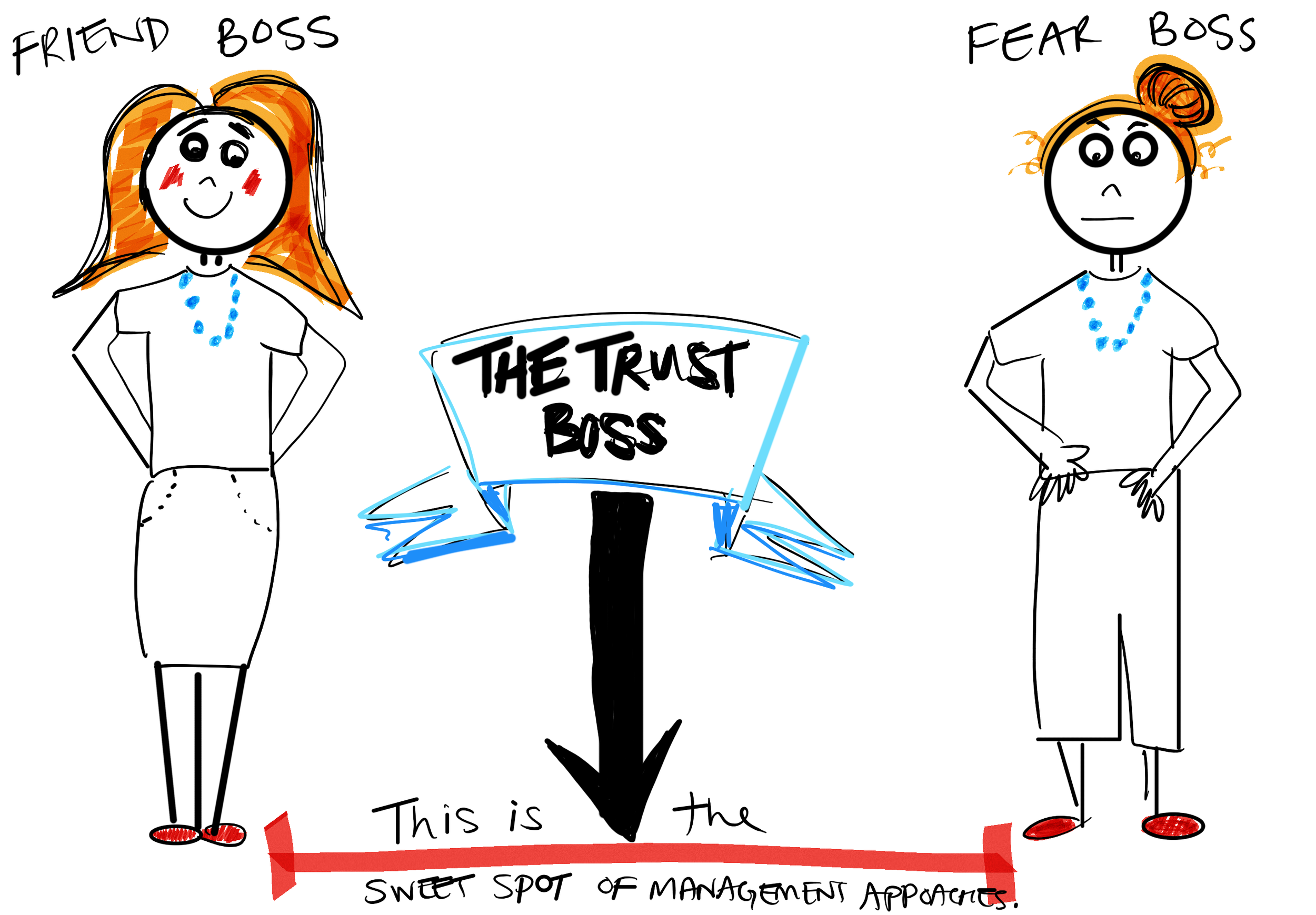Good bosses are not accidental—their behaviors and choices are intentional.
So, how do you intentionally think about the leadership style you want to have as a boss or manager of a team? Well, it all starts with understanding what makes a leader a leader.
Tom Rath and Barry Conchie, coauthors of Strengths Based Leadership: Great Leaders, Teams, and Why People Follow, set out to understand how to become a better manager and what motivates us to follow great leaders. They found four principle reasons why the best managers succeed:
We trust them
They’re compassionate
They provide a sense of stability
They give us a sense of hope
These four basic needs—trust, compassion, a sense of stability, and a sense of hope—are not only essential to becoming a better manager, but also critical to your success. So, as part of our manager training workshop, The Manager Toolkit, we dive into what the research says and how to build the skills necessary to deliver on each of these needs.
In this post, we’re going to take a closer look at the first need: trust.
The Management Spectrum
In The Harvard Business Review Manager's Handbook: The 17 Skills Leaders Need to Stand Out, they lay out a pretty handy management spectrum. At one end of the spectrum is the Friend Boss: leaders who strive to be liked, and at the other end is the Fear Boss: leaders who demand compliance.
The Friend Boss approaches management by treating the team they manage as friends, which means they are often defending their team’s behaviors because of the social dynamics at play rather than focusing on performance. This kind of manager ties their expectations of their team members to the context of their personal relationship. Often you catch this kind of manager saying something like, “Can you do this for ME?”
The challenge here is that when it comes to the modern dynamics of a workplace, it is very hard to be effective as a manager while maintaining those friendships.
Take for instance, promoting someone; you can’t choose all your friends to come to the party. So, how will your other friends take it when you can only choose one? What about giving some tough feedback to a team member? Think about it this way: do you like talking to your friends about their performance and how their behavior needs to change? That dynamic sounds terribly uncomfortable for you and the individual(s) with whom you need to have that conversation.
Now, taking a look at the other side of the spectrum. The Fear Boss doesn’t seek to build relationships with their team the way the Friend Boss does, rather they threaten and manage with ultimatums. A Fear Boss often dictates work activities with a “do this or else...” approach. It doesn’t feel good for the team they are managing, and the manager will struggle to build a healthy functioning team.
At the end of the day, people aren’t driven by a big ego. Moreover, there’s research that indicates leaders who manage through fear aren’t just creating a negative experience for one employee, but rather are building a toxic culture for everyone working on that team and beyond. Negativity breeds more negativity—it’s a virus with no cure.
Now, these are the extremes, meaning you may not always fall in one of those two categories. However, extremes are helpful when considering your behavior and actions as a manager. For instance, you may not consider yourself a Fear Boss, but perhaps you’ve said something in the past to your team like, “If you don’t hit your numbers, you won’t __________ (fill in the blank).” That behavior is very much aligned with creating a culture of fear.
So, what’s the sweet spot of management approaches? What’s between the Friend and Fear Boss? It’s learning how to be a Trust Boss.
Becoming a Trust Boss to be a Better Manager
A Trust Boss is someone who builds genuine trust with their team through competency, integrity and a good character. So, how does one go about doing that? Well, at The Group Forward, here are some of our top recommendations for developing your sweet spot Trust Boss management approach:
1) Have your own work on lock down
Many bosses are responsible for managing and tracking the performance of their team while also delivering work results themselves. Make sure, as a manager, you know what you’re doing, how to do it well, and that your value and talent is clear. If you have room to improve and learn, prioritize it so you can continue to crush it in what you do.
2) Have their work on lock down
Do you know what your team is doing? Do you understand their challenges and opportunities? Are you clear on how you can support them in your management role? Empathy matters.
Try job shadowing if you don’t know what certain members on your team do. If your team is rather large, can you get more management support or create a way for your team to share the ins and outs of their job with you? You don’t have to know the intimate details, but you’ll be a lot more relevant if you empathize with the type of work they do. For example, try doing something they do—you'll learn a lot more by empathizing with their work experientially than if you just talked about in a check-in.
3) Spontaneously show you care by walking around
The best managers walk around. Get up from your desk or regular seated spot and go see what your team is doing. In too many meetings? Block out time where you can go see your team working. Start spontaneous conversations to make sure they know you’re around and on their side.
If you manage team members in a virtual context, call your team members to check in. Don’t schedule the call or tie it to a conversation about a specific work task, rather just check in to see how they’re doing and how work is going.
It’s these spontaneous check-ins that often reap the most benefit for a trusting relationship. It communicates “I care about you,” and these good intentions lead people to understand you have nothing but good intentions. Good intentions lead to you building credibility. Credibility leads to you being known as someone with integrity.
4) Loop them in on your thinking and provide context (explaining the why, when you can)
When you provide context and the rationale behind why a decision is being made, it helps people understand the decision better. They may not agree with the decision, but understanding ultimately leads to respect.
When I joined a big organization and inherited a large team to manage, I began putting my stamp on our department’s way of working. But I also wanted to recognize that change can be hard for some people. I made it a point to provide context. In team meetings, in one-on-ones and even in email communication, I explained why we were going to change something or why something needed to happen before explaining what the change or need was. And it helped build goodwill amongst the team.
5) Do what you say you’re going to do and when you can’t, make it right
We all learned this at a young age (and as a mom of 2 young boys, it has become apparent just how early it happens!). When you do what you say you’re going to do—deliver a project on time, support someone in a specific way, give time towards something that needs it—you are building trust.
However, when you can’t deliver on your promises, you have to make it right. You have to acknowledge your shortcomings, take ownership of your mistakes, and, when needed, apologize and mean it. Sometimes that means taking ownership for something out of your control or someone else not being able to live up to what they promised—welcome to management!
Once you’ve owned it, make a plan for how you’ll fix what’s going on and what you’ll do next time to make it better. Be a human and the team you manage will respect your humanity.
Now it’s your turn. As you’re considering your leadership style, think about the ways you can show your team that you have Trust at the center of your management approach. And remember, becoming a better manager isn’t an overnight metamorphosis, it’s a journey that takes time and a lot of hard work. Set yourself up for success by setting realistic goals and creating opportunities for reflection and feedback. You’ve got this!
Interested in learning more about The Group Forward’s Manager Toolkit training? Shoot us a note.







